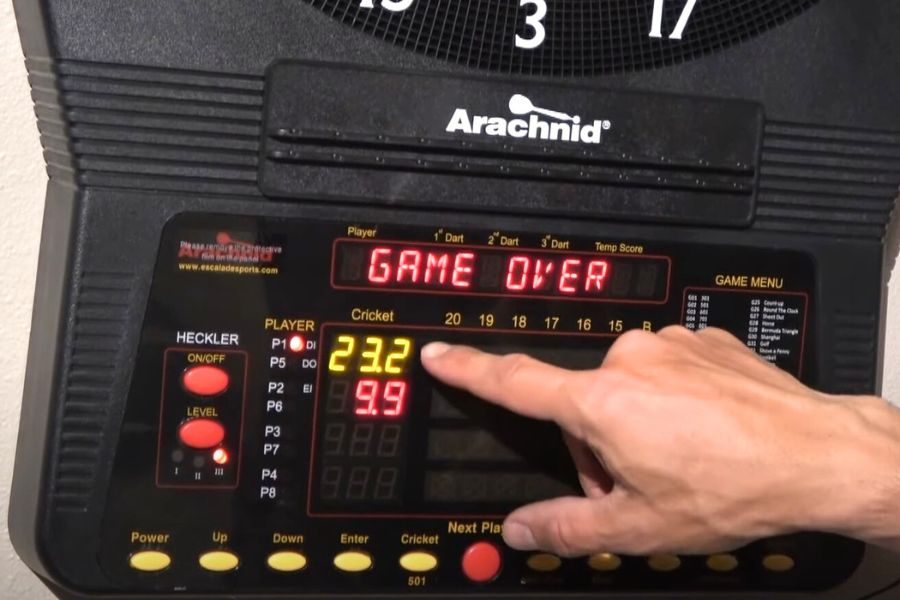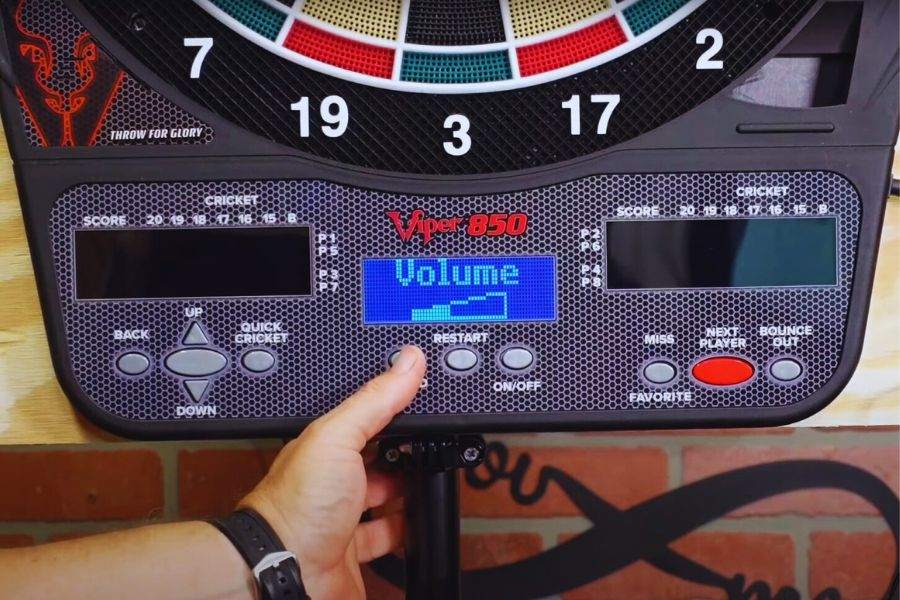I’ll never forget the look of pure excitement that lit up my sister Sarah’s face when I gifted her a brand-new electronic dartboard setup on her 14th birthday, replacing our old wooden board in the gaming room.
Questions flowed from her like a river: “Gee, how do you play on this board? What do all these buttons do? Tell me about these game modes.” I couldn’t blame her curiosity; I too was initially overwhelmed by the wealth of cool features.
But, fret not. Playing digital darts is a breeze, especially if you’re keen on exploring various dart games. Allow me to take you on a thorough journey, demystifying everything step by step with tips, tricks, and strategies.
Gearing Up For Electronic Darts
Electronic darts, a modern twist on the classic pub game, combine precision and fun in a tech-savvy way. Whether you’re setting up a dartboard for casual entertainment or competitive play, a few essential items are needed to get started.
Now, I’ll walk you through the things you need to embark on your electronic darts journey. From the dartboard itself to the perfect lighting setup, here’s what you need to ensure an engaging and enjoyable experience:
Electronic Dartboard: The heart of your setup is the dart board itself. Unlike traditional boards, those are equipped with sensors that accurately register your dart throws. Their surface is made of plastic or resin, with hundreds of tiny holes to catch the darts. The best electronic dart boards come in various designs, from sleek and modern to more classic styles, catering to different preferences.
Soft-Tip Darts: To play with a digital board, you’d need soft-tip darts with rubber or plastic tips, as steel darts can cause damage to sophisticated boards. They come in various weights and styles, allowing players to choose the one that suits their throwing style. In this regard, I should mention that the soft-tipped darts are one of the biggest reasons I prefer digital dartboards – they are much safer for home use with my family.
Power Supply: Most electronic dartboards require a power source to operate. They can be plugged into a standard electrical outlet, so ensure you have an accessible power socket nearby. If you opt for a battery-powered board, have fresh batteries on hand for uninterrupted gameplay.
Adequate Space: Create a dedicated playing area with enough space around the dart board. Ensure there is sufficient clearance for participants to step up to the throwing line and safely retrieve their darts. Make sure to do the right height and distance measurements when setting up your electronic board.
Lighting: Proper lighting is essential for visibility and accuracy in electronic darts. Bright, evenly distributed lighting helps players clearly see the dartboard and target areas. Consider using overhead lighting or wall-mounted fixtures to eliminate shadows and create an optimal environment. LED lights are a popular choice due to their varieties and features.
By paying attention to these key components and details, you’ll be well-prepared to enjoy a satisfying game of soft-tip electronic darts with friends and family. Whether you’re aiming for precision or just having fun, setting up your game zone thoughtfully enhances the overall gaming experience.
Also Read: Soft-Tip Vs Steel-Tip Darts
Step-By-Step Guide To Play Electronic Darts
I found it pretty easy to set up my soft-tipped dartboard and get started, thanks to the detailed instruction manual that came with it. Here’s a step-by-step guide to using these modern boards.
Step 1: Mounting The Dartboard
Mounting up the electronic dartboard properly is more important than you’d realize. Regardless of whether the hang holes are vertical or horizontal, the center of the bullseye should be 5 feet, 8 inches above the ground. Also, make sure there are at least 10 feet of space available in front of the board – you need to throw the darts from 8 feet away.
- Measure the distance between the hang holes.
- Mark the spots for the hang holes in the wall, making sure to keep them at level with each other.
- Drill a screw on each of the markings you made.
- Line up the hang holes with the screws to mount the dartboard on the wall.
- Fasten the screws to ensure a snug fit – you wouldn’t want the dart board to fall off.
- Plug the AC adapter into a compatible power source.
My dart board also had four holes in the catch ring area, so I fastened a screw into each of them to make it as secure as possible.
Step 2: Understanding The Layout Of The Board
Take a moment to acquaint yourself with the electronic dartboard. While it resembles a traditional dartboard, it comes with additional features:
- Bullseye: The center of the board is, divided into an inner (50 points) and outer (25 points) bullseye.
- Triple and Double Rings: These red and green rings surrounding the numbers offer triple (3x) and double (2x) points, respectively.
- Numbered Sections: The numbered sections from 1 to 20, each with its own point value.
Step 3: Exploring The Functions
Discover the electronic dartboard’s functions and enhance your experience! To start, explore buttons that power your game, customize settings, and then take control of your darting adventure.
- Start/Hold: This button is like the ignition switch for your dartboard adventure. Press it to kickstart a game or hit pause when you need a breather between rounds. The hold function? Well, that’s there so you can safely retrieve your soft-tipped darts from the board.
- Game Group: After powering on your digital dartboard, press the “Game” button. You’ll see a bunch of game groups that are cooler than many video game levels. Take your pick and get ready to dive into the action!
- Game Mode: Ready for the next level of excitement? Press “Option,” and, you’re presented with a bunch of game modes, each with its own funky codename. Pick the one that resonates with your preferences!
- Number Of Players: Dartboarding is way more fun when you’ve got a gang of friends in on the action. Hit that “Player” button on your electronic dart board to decide how many of your buddies will join you on this adventure. Will it be a head-to-head showdown or a full-blown dartboard party? You call the shots!
- Teams: Now, it’s time to get strategic. Press “Team,” and you’ll be able to decide how many teams will go head-to-head in this epic challenge. Will you be the team captain leading your squad to victory, or are you ready to go it solo?
- Handicap (optional): Hold on, there’s a surprise! In the world of darts, not everyone’s a pro. No worries, though – with the “Handicap” button, you can level with the skill of the opponent. Choose a team, adjust the difficulty with the “Option” button, and give everyone a chance to shine. It’s like customizing your game to make it as challenging (or easy) as you want.
- Game Guard: Imagine this button as your electronic dartboard’s shield. Once you’ve hit “Start” and the game is in full swing, the Game Guard locks down all the other buttons. No accidental button mishaps are allowed! It’s all about keeping your game on track and delay-free.
- Bounce Out: Ever had a dart do a trick and bounce off the board? This button gives you the power to decide if those bounced darts should count. If you do not want them to be registered, press this button right after a bounce-out to deduct the score.
- Dart Out/Score: This is another dual-function button used to display certain information. The Dart Out feature is available only when your score falls below 160 in a “01” game (301, 401, etc.). It allows you to get a suggestion from the dartboard on the last three darts required to win the game – something I have found really helpful. The Score feature enables you to view the points if it isn’t currently being displayed.
- Double/Miss: In “01” games, this button activates the Double In/Double Out and Master Out options. However, the latter isn’t available in all soft-tipped dartboards. The Miss feature, which is active during all electronic dart games, allows you to make the board register a missed dart that lands outside the target area.
- Sound: The Sound button controls the volume for your dart board’s musical and voice effects.
Step 4: The Art Of Aiming And Throwing Darts
Now, let’s delve into the crucial art of dart throwing. Aiming for precision and consistency, your technique plays a pivotal role in your success. In my experience, beginning by establishing a stable stance can help a lot, with your dominant foot slightly forward, evenly distributing your weight.
Next, adopt a relaxed grip on the dart, ensuring your fingers control it without excessive force. Focus your gaze on a specific target area, such as the triple 20 or bullseye, to maintain accuracy. As you initiate the throw, extend your arm straight, following through with a smooth, controlled motion.
Remember, it’s finesse, not force, that yields success. Here is a detailed guide on the right way to throw soft-tip darts on an electronic dartboard. Practice diligently to refine your technique and hit those bullseyes like a pro!
Step 5: Scoring
Electronic dartboards are equipped with sensors that detect where your darts land on the board. When a dart hits a specific segment, the technology calculates the score instantly and updates it on the LED display.
Each section of the dartboard has its own point value, as mentioned earlier. Here’s a quick recap:
- Bullseye: The central Bullseye is divided into an inner Bullseye (worth 50 points) and an outer Bullseye (25 points).
- Triple Ring (3x): Landing a dart in the Triple Ring of a numbered section multiplies the section’s value by 3.
- Double Ring (2x): The Double Ring doubles the point value of the numbered section it encircles.
- Numbered Sections (1-20): These sections have point values from 1 to 20, which are not multiplied unless you hit the Triple or Double Ring.
Step 6: Enjoy And Improve
Lastly, remember that electronic darts is about enjoyment and skill development. Embrace the journey, challenge your friends, and relish countless hours of dart-throwing excitement. As you practice and gain experience, your skills will undoubtedly improve, making each game more rewarding.

Games To Play On An Electronic Dart Board
Electronic dartboards have truly won me over, and here’s why: they offer a passport to a world of dart games, each more exciting than the last. While these games are technically playable on traditional boards, it’s the digital magic that truly shines. With automated scoring and life deduction features, those boards make the game not just accessible but also more thrilling.
Simple Cricket
In simple cricket, only the segments from 15 to 20 and the bullseye on an electronic dartboard are usually valid. The goal? Be the first to conquer these targets and emerge victorious. But here’s the kicker: there are variations aplenty, each with its own set of rules:
- 000: This one is the easiest for beginners – you may hit the segments 15, 16, 17, 18, 19, 20, and the bullseye in any order.
- 020: Here, precision is the name of the game. You’re required to hit the segments in this specific order – 20, 19, 18, 17, 16, 15, and ultimately the bullseye.
- 025: This is just the opposite of the 020 mode – you’d have to hit the segments in the reverse order, starting with the bullseye.
Scram Cricket
Scram Cricket takes the essence of simple cricket and adds a thrilling turn. In this game, only the bullseye and sectors 15 to 12 of your dart board are in play. But here’s where it gets exciting – it’s a two-round showdown.
In the first round, one player aims to close the segments with just three hits, while their opponent strives to rack up points by hitting the open segments. Once the first participant shuts all the segments on the electronic dartboard, they swap roles, and round two kicks off.
At the end of this nail-biting duel, the player with the highest score emerges as the ultimate Scram Cricket champion. It’s darting drama at its finest!
Score Cricket
Score Cricket brings the spotlight back to the bullseye and segments 15 to 20. The rules are simple: you can “open” and “own” a segment by hitting it three times, after which you may continue to collect points from that segment.
The goal? Achieve the highest score by the time all segments of the electronic board are sealed. Score Cricket offers three thrilling modes – E00, E20, and E25, mirroring the excitement of 000, 020, and 025 modes in Simple Cricket. Get ready for a darting adventure like no other!
Cut Throat Cricket
In my experience, the Cut Throat Cricket is the most exciting electronic dart game. Like the rest of the cricket games, only the segments 15 to 20 and the bullseye are scored. You may or may not be required to hit the segments in a specific order. However, here’s the twist – the order of hitting those segments varies depending on the game mode (C00, C20, or C25).
But what truly sets Cut Throat Cricket apart is its cunning strategy. Every time you earn points from an open segment on the dartboard, those points don’t go into your account; they’re handed over to the other players. The game continues until all segments are closed.
Double Score Cricket
Double Score Cricket is a more challenging version of the score cricket game, where you’re required to hit the double zone of each segment first. Until then, none of your hits will be registered. The rest of the rules remain the same.
Shove-A-Penny Cricket
In Shove-a-penny cricket, your aim is to fill all three bars within each segment of the dartboard, covering 15 to 20 and the bullseye. You earn one bar each time you close a round by hitting the double or triple zone of a segment on your electronic dart board.
The interesting part is that once a segment is closed, it remains off-limits in subsequent rounds, denying your opponent any chance to score. It adds a strategic layer to the game, making it even more captivating!
Round The Clock
In Round The Clock, the segments in play depend on your chosen options before the game begins. Here’s how it works: players must aim for the segments highlighted by the digital dart board.
Upon hitting an area, the electronic dartboard promptly responds with “Yes” or “No,” while also revealing the next segment. The ultimate goal is for the first player to successfully land darts on all the designated segments to win.
Round The Clock (Double)
As you may have guessed from the name, this game is almost the same as Round the Clock. However, you can only score by hitting the double zones of the active segments. I’d say this is more of a game for advanced players, as beginners might find it too challenging.
Round The Clock (Triple)
If you’re a fan of Round the Clock and would like to take the difficulty level a notch higher, try this “triple” version on your dartboard. It’s the same as the regular and double modes, except you can only score when you hit the triple zones.
Legs Over
In this game, every player kicks off with a specific number of lives, as determined by the chosen option – be it 3, 5, 7, 9, 11, 13, 15, 17, 19, or 21. It all begins with the dartboard flashing a number on its screen.
The first player’s goal is to match or surpass this score using just three soft-tip darts; a life is forfeited for falling short. The following players would consequently have to reach a higher score to avoid losing a life. As the participants retire one by one after losing all their lives, the last one standing wins the electronic darts game.
Legs Under
In this dartboard game, players begin with a predetermined number of lives, just like in Legs Over. However, there’s a twist in Legs Under – your objective is to reach a lower score than the displayed target, using only three throws. Surpassing the target or scoring zero costs you a life.
The following players then step up, each endeavoring to achieve a lower score than their predecessor. The winner is determined in the same way as in Legs Over – you have to be the last one remaining once everyone else is eliminated.
Count Up
Simple and easy, Count Up is one of the best electronic dart games, particularly for beginners, and one of my sister’s favorites. You have to select a target score at the beginning, which can be 100, 200, 300, 400, 500, 600, 700, 800, or 900. All segments of the dartboard are valid in this game, and the first player to reach the target score wins.
Count Down
Enter the realm of countdown games, also known as ’01 games. Here’s the lowdown: each player kicks off with a certain starting score, be it 101, 201, 301, and beyond. As the rounds unfold, scores are automatically deducted from their initial score. The first player to reach exactly zero wins the game.
But there’s a surprising catch! You can supercharge the excitement with the ‘Double In/Double Out’ function on the dart board, where the game demands double hits for both the start and finish.
High Score
This is the most elementary dart game for starters. Here, the objective is as straightforward as it gets – outscore your opponents over a set number of rounds.
Each round comprises three dart throws, with the number of rounds determined by the option name (H03 for three rounds, H05 for five rounds, and so forth). It’s a game that’s easy to grasp and quick to enjoy, making it a perfect choice for some laid-back darting fun!

Tips And Tricks To Play Electronic Darts
- Perfect Your Stance: Begin with a solid stance. Stand with your dominant foot forward, ensuring your weight is evenly distributed for balance. A consistent stance is the foundation of accuracy.
- Grip Like a Pro: Maintain a relaxed grip on the dart. Your fingers should guide the throw without excessive force. Experiment with different grips to find what suits you best.
- Eye on the Target: Always keep your eyes locked on your target, whether it’s the triple 20 or bullseye. Visualize your desired outcome with each throw.
- Smooth Release: As you throw, maintain a straight arm and execute a smooth, controlled motion. Avoid jerky or forceful releases; instead, let your dart glide with finesse.
- Practice Precision: Dedicate time to practice regularly. Focus on specific segments, work on your aim, and fine-tune your technique. Consistency comes from practice.
- Master The Math: Familiarize yourself with the game rules and scoring systems of various dart games. Understand the strategies involved in each to gain an edge over your opponents.
- Explore Game Variations: Don’t limit yourself to one game. Explore different dart game variations like cricket, 01 games, and more. Each game offers a unique challenge and keeps your skills sharp.
- Stay Cool Under Pressure: Maintain composure during intense moments. Dart games can get competitive, but keeping a calm demeanor improves your focus and performance.
- Adjust to Conditions: Be adaptable. Factors like lighting, board condition, and even your opponents’ style can vary. Learn to adjust your game accordingly.
- Analyze Your Throws: Use technology to your advantage. Analyze your throw data, if available, to identify areas for improvement. Many soft-tip electronic dartboards offer this feature.
- Seek Coaching: Consider getting professional coaching or learning from experienced players. They can provide valuable insights and help you refine your skills.
- Compete Regularly: Participate in local leagues or tournaments to gain valuable experience and measure your progress against other players.
- Mental Toughness: Develop mental resilience. Stay focused on the game, block out distractions, and maintain confidence in your abilities.
- Learn From Mistakes: Embrace failures as learning opportunities. Analyze your mistakes, and use them as stepping stones toward improvement.
- Enjoy the Journey: Above all, remember that darts are meant to be fun. Enjoy the flow of the game, celebrate your successes, and savor every moment on your journey to becoming a soft-tip electronic darts expert.
Indeed, playing electronic darts offers a range of complexity levels. Regardless of your choice, dart board games promise endless enjoyment once you’ve mastered the basics. I trust you’re now ready to dive into the world of digital darts and embark on an exciting journey. So, gather your friends, aim for those bullseyes, and let the adventure begin!

